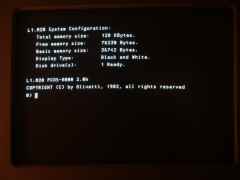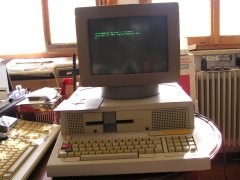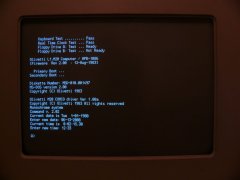Introduction to PCOS and other operating systems
This section is intended to give a short introduction of PCOS to a new user which found an Olivetti M20, managed to find the PCOS boot disks and wants to start using the computer. In the Manuals section of the site, you can find manuals describing in detail PCOS and its commands.
PCOS was the operating system developed by Olivetti for the M20 and the L1 computers made between 1982 and 1985. It is a single-user single-task operating system (like MS-DOS and CP/M) and was command driven.

File names were 14 characters long and every volume and file can be protected with a 14 character password. The original PCOS 1.0 does not make use of directories and 192 files could be saved in each volume. It is worth remember that the first versions of MS-DOS had similar limitations.
Anyway, the PCOS allowed to be customized in order to match the user's needs. For example, the command pload allowed to make resident a command and the customized version of PCOS could be saved with psave.
PCOS most frequently used commands
| Command: | Shortcut: | Meaning: |
|---|---|---|
| vformat | vf | Format a volume (disk). For example: vf 1: format the disk in the drive 1: (the left one) |
| vrename | vr | Change the name of a volume (disk). For example: vr 1:,newname change the volume title of the disk 1: (the left one) |
| vpass | vp | Change the volume password. |
| vlist | vl | Show the volume file list (directory listing). |
| vquick | vq | Show the volume file list. Less detailed than vl but much faster |
| vcopy | vc | Make a backup copy of the volume. Example: vc 0:, 1: copy the disk in drive 0: to the disk in drive 1: |
| fcopy | fc | Copy a file. |
| flist | fl | Read the content of a text file. |
| basic | ba | Launch the Microsoft Basic interpreter. |
| dconfig | dc | Shows the system configuration: Example: dc %hm show the hardware and memory configuration |
| slanguage | sl | Select the language of the system (keyboard layout, regional settings...) |
The CP/M-8000
 The CP/M was a very successful operating systems which was very diffused in professional 8-bit computers based on the Zilog Z80.
The development of 16 bit processors such as the Intel 8086 led to the adaptation of the CP/M for these processors.
The CP/M86, able to run on the Intel 8086, was superseded by the MS-DOS and never caught the market.
The CP/M was a very successful operating systems which was very diffused in professional 8-bit computers based on the Zilog Z80.
The development of 16 bit processors such as the Intel 8086 led to the adaptation of the CP/M for these processors.
The CP/M86, able to run on the Intel 8086, was superseded by the MS-DOS and never caught the market.The Olivetti M20 was able to boot a particular version of the CP/M based on the Zilog Z8000 processor. It is possible to found the sources of this operating systems at http://www.cpm.z80.de/source.html.
Dwight Elvey has worked a lot on the CP/M-8000. The image on the right was taken from Carlo's pages.
The MS-DOS
 Early versions of main IBM PC operating system could be booted on the Olivetti M20 with an optional expansion card which provided the Intel 8086 processor and the BIOS needed to run the MS-DOS (photo courtesy of Andreas Senk). For a photo album of the APB8086 and a few screenshots, check here.
Early versions of main IBM PC operating system could be booted on the Olivetti M20 with an optional expansion card which provided the Intel 8086 processor and the BIOS needed to run the MS-DOS (photo courtesy of Andreas Senk). For a photo album of the APB8086 and a few screenshots, check here.
Olivetti is a registered trademark of Telecom Italia. This site is not related to Olivetti nor to Telecom Italia. The material presented is meant for personal use only and is shared in a "fair use" spirit. If you own the copyright of some of the stuff presented here and you think it should be removed, please contact the webmaster.


